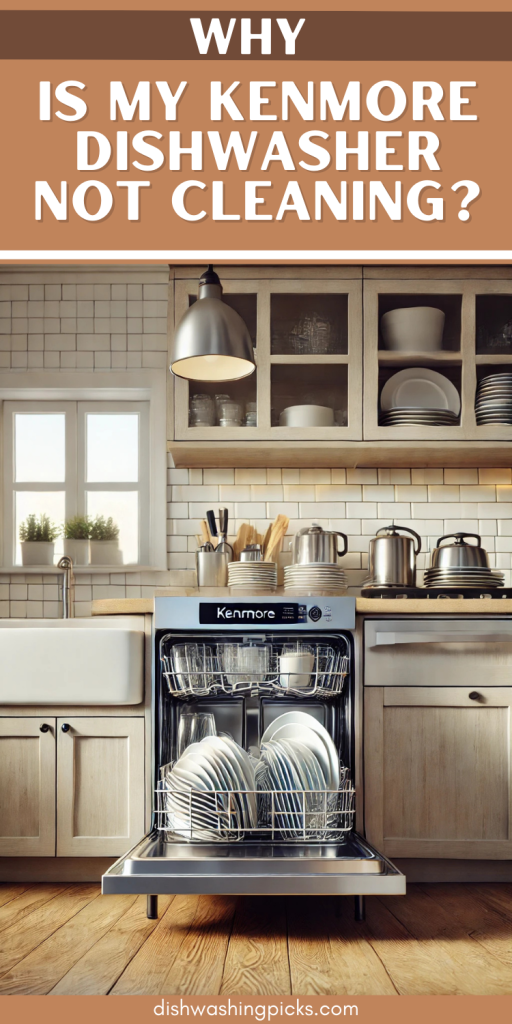
The Mystery of the Dirty Dishes
You load up your Kenmore dishwasher, press that magic start button, and walk away, expecting to return to sparkling clean plates. But when you open the door—bam!—you’re greeted with half-washed dishes, food residue, and maybe even a funky smell. What’s going on?
Before you start contemplating life without a dishwasher (shudder), let’s troubleshoot. If your Kenmore dishwasher isn’t cleaning properly, it’s not just being stubborn—there’s a reason behind it. And the good news? Most of these issues are easy to fix!
So, let’s play detective and uncover the problem. Is your dishwasher struggling with greasy dishes? Leaving behind crumbs? Are glasses coming out cloudy? No worries—we’re about to tackle all of that, step by step.
1. The Spray Arms: Are They Stuck or Clogged?
Picture this: You’re trying to clean your car, but instead of a powerful hose, you’ve got a tiny trickle of water. That’s exactly what happens when your spray arms aren’t working properly. They’re responsible for spraying water at high pressure to blast away food bits, but if they’re clogged or stuck, your dishes are in trouble.
Quick Fix:
- Check for blockages. Food debris, hard water buildup, or even a sneaky piece of plastic wrap could be clogging the spray arm holes.
- Give them a deep clean. Remove the spray arms, rinse them under warm water, and use a toothpick or small brush to clear out clogged nozzles.
- Make sure they can spin freely. If a large pan or plate is blocking them, water won’t reach all your dishes evenly.
Pro Tip: If you hear weird rattling noises during a cycle, a spray arm might be hitting something. Rearrange your dishes to give it room to spin!
2. The Filter: A Gunk Magnet You Might Be Ignoring
Ever wonder where all the food bits and grease go when your dishwasher washes your dishes? Surprise—they don’t just vanish into thin air! That’s what your dishwasher filter is for. But if it’s clogged, it’s like washing your dishes in dirty dishwater (yikes).
Quick Fix:
- Locate the filter. It’s usually at the bottom of the dishwasher, under the spray arm.
- Twist and remove it. If it’s covered in gunk, that’s probably your issue.
- Rinse under warm, soapy water. Use a soft brush (or an old toothbrush) to scrub off stubborn grime.
- Pop it back in. Your dishwasher will thank you!
Pro Tip: Clean your filter once a month to keep your dishwasher running at peak performance. If you’ve never cleaned it before, now’s the time!
3. Detergent Disasters: Are You Using the Right One?
Think all dishwashing detergents are the same? Think again! The wrong detergent (or too much of the right one) can actually leave your dishes dirtier than before. If you notice streaks, cloudy glasses, or a weird filmy residue, your detergent might be the culprit.
Quick Fix:
- Use a high-quality detergent. Pods, powder, or gel—all work fine, but some brands perform better than others.
- Don’t overdo it. Too much detergent can leave a soapy buildup on your dishes. Follow the recommended amount on the packaging.
- If you have hard water, consider using a detergent with built-in rinse aid to prevent mineral deposits.
Pro Tip: If your dishes come out with white spots, run a vinegar cycle by placing a cup of white vinegar in the top rack and running a hot water cycle. It helps break down buildup!
4. Is Your Water Hot Enough?
Cold water just won’t cut it. Your Kenmore dishwasher needs hot water (120–140°F / 49–60°C) to break down grease, dissolve detergent properly, and sanitize your dishes.
Quick Fix:
- Run hot water from the sink before starting your dishwasher. This ensures hot water gets to the machine immediately.
- Check your water heater settings. If your water isn’t hot enough, your dishwasher can’t do its job properly.
- Use the “High-Temp Wash” or “Sanitize” setting if your model has it—this boosts the water temperature for better cleaning.
Pro Tip: If your dishes feel greasy even after a full cycle, lukewarm water could be the reason!
5. Are You Loading It Like a Pro?
Believe it or not, how you load your dishwasher matters. If dishes are too tightly packed, the water and detergent can’t reach everything, leaving you with half-clean plates and cups.
Quick Fix:
- Top rack: Cups, glasses, small bowls—tilt them slightly so water doesn’t pool inside.
- Bottom rack: Plates, large bowls, and pots—make sure nothing blocks the spray arms.
- Silverware basket: Mix forks, spoons, and knives to avoid “nesting” (when utensils stick together and don’t get clean).
Pro Tip: Do NOT block the detergent dispenser! If a plate or pan is in the way, the detergent might not even get released properly.
6. Time for a Deep Clean?
Yes, your dishwasher washes dishes, but that doesn’t mean it cleans itself! Grease, soap scum, and food particles build up over time, affecting performance. If your dishwasher smells funky or isn’t cleaning well, it’s overdue for a deep clean.
Quick Fix:
- Wipe down the inside with warm, soapy water. Don’t forget the door gasket and the bottom of the tub.
- Run a vinegar cycle: Place a cup of white vinegar on the top rack and run a hot water cycle (no detergent).
- Use baking soda: Sprinkle baking soda on the bottom of the dishwasher and run a short hot cycle for extra freshness.
Pro Tip: If you live in a hard water area, mineral buildup can clog spray arms and filters faster. A monthly dishwasher cleaner can help prevent this!
7. When to Call for Backup
If you’ve tried all these fixes and your Kenmore dishwasher still isn’t cleaning properly, it might be time to call in a pro.
Signs you need a technician:
- The dishwasher won’t fill with water or won’t drain properly.
- It makes loud, unusual noises during a cycle.
- There’s a persistent error code that won’t go away.
Most dishwasher issues are easy to fix, but if yours is acting up even after all these troubleshooting steps, a professional repair might be your best bet.
Final Thoughts: No More Dirty Dishes!
A Kenmore dishwasher that won’t clean properly is frustrating, but with a little troubleshooting, you can usually get it back to its dish-blasting best. Whether it’s a clogged filter, detergent issues, or poor water temperature, these fixes should help you avoid hand-washing (ugh) and keep your dishes sparkling clean.
Now go show your dishwasher some love and enjoy spotless dishes again!
